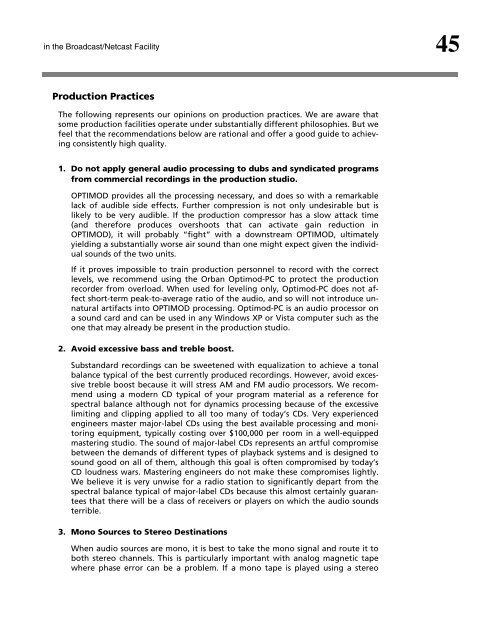Maintaining Audio Quality in the Broadcast Facility 2011 - Orban
Maintaining Audio Quality in the Broadcast Facility 2011 - Orban
Maintaining Audio Quality in the Broadcast Facility 2011 - Orban
You also want an ePaper? Increase the reach of your titles
YUMPU automatically turns print PDFs into web optimized ePapers that Google loves.
<strong>in</strong> <strong>the</strong> <strong>Broadcast</strong>/Netcast <strong>Facility</strong> 45<br />
Production Practices<br />
The follow<strong>in</strong>g represents our op<strong>in</strong>ions on production practices. We are aware that<br />
some production facilities operate under substantially different philosophies. But we<br />
feel that <strong>the</strong> recommendations below are rational and offer a good guide to achiev<strong>in</strong>g<br />
consistently high quality.<br />
1. Do not apply general audio process<strong>in</strong>g to dubs and syndicated programs<br />
from commercial record<strong>in</strong>gs <strong>in</strong> <strong>the</strong> production studio.<br />
OPTIMOD provides all <strong>the</strong> process<strong>in</strong>g necessary, and does so with a remarkable<br />
lack of audible side effects. Fur<strong>the</strong>r compression is not only undesirable but is<br />
likely to be very audible. If <strong>the</strong> production compressor has a slow attack time<br />
(and <strong>the</strong>refore produces overshoots that can activate ga<strong>in</strong> reduction <strong>in</strong><br />
OPTIMOD), it will probably “fight” with a downstream OPTIMOD, ultimately<br />
yield<strong>in</strong>g a substantially worse air sound than one might expect given <strong>the</strong> <strong>in</strong>dividual<br />
sounds of <strong>the</strong> two units.<br />
If it proves impossible to tra<strong>in</strong> production personnel to record with <strong>the</strong> correct<br />
levels, we recommend us<strong>in</strong>g <strong>the</strong> <strong>Orban</strong> Optimod-PC to protect <strong>the</strong> production<br />
recorder from overload. When used for level<strong>in</strong>g only, Optimod-PC does not affect<br />
short-term peak-to-average ratio of <strong>the</strong> audio, and so will not <strong>in</strong>troduce unnatural<br />
artifacts <strong>in</strong>to OPTIMOD process<strong>in</strong>g. Optimod-PC is an audio processor on<br />
a sound card and can be used <strong>in</strong> any W<strong>in</strong>dows XP or Vista computer such as <strong>the</strong><br />
one that may already be present <strong>in</strong> <strong>the</strong> production studio.<br />
2. Avoid excessive bass and treble boost.<br />
Substandard record<strong>in</strong>gs can be sweetened with equalization to achieve a tonal<br />
balance typical of <strong>the</strong> best currently produced record<strong>in</strong>gs. However, avoid excessive<br />
treble boost because it will stress AM and FM audio processors. We recommend<br />
us<strong>in</strong>g a modern CD typical of your program material as a reference for<br />
spectral balance although not for dynamics process<strong>in</strong>g because of <strong>the</strong> excessive<br />
limit<strong>in</strong>g and clipp<strong>in</strong>g applied to all too many of today’s CDs. Very experienced<br />
eng<strong>in</strong>eers master major-label CDs us<strong>in</strong>g <strong>the</strong> best available process<strong>in</strong>g and monitor<strong>in</strong>g<br />
equipment, typically cost<strong>in</strong>g over $100,000 per room <strong>in</strong> a well-equipped<br />
master<strong>in</strong>g studio. The sound of major-label CDs represents an artful compromise<br />
between <strong>the</strong> demands of different types of playback systems and is designed to<br />
sound good on all of <strong>the</strong>m, although this goal is often compromised by today’s<br />
CD loudness wars. Master<strong>in</strong>g eng<strong>in</strong>eers do not make <strong>the</strong>se compromises lightly.<br />
We believe it is very unwise for a radio station to significantly depart from <strong>the</strong><br />
spectral balance typical of major-label CDs because this almost certa<strong>in</strong>ly guarantees<br />
that <strong>the</strong>re will be a class of receivers or players on which <strong>the</strong> audio sounds<br />
terrible.<br />
3. Mono Sources to Stereo Dest<strong>in</strong>ations<br />
When audio sources are mono, it is best to take <strong>the</strong> mono signal and route it to<br />
both stereo channels. This is particularly important with analog magnetic tape<br />
where phase error can be a problem. If a mono tape is played us<strong>in</strong>g a stereo



![[PDF] Using the ITU BS.1770-2 and CBS Loudness Meters ... - Orban](https://img.yumpu.com/50629372/1/190x245/pdf-using-the-itu-bs1770-2-and-cbs-loudness-meters-orban.jpg?quality=85)






![[PDF] Optimod-FM Feature Comparison - Orban](https://img.yumpu.com/41741615/1/190x245/pdf-optimod-fm-feature-comparison-orban.jpg?quality=85)






